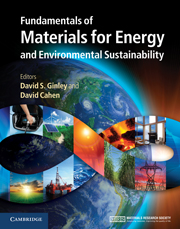Book contents
- Frontmatter
- Contents
- Contributors
- Preface
- Acknowledgments
- Part 1 Energy and the environment: the global landscape
- Part 2 Nonrenewable energy sources
- Part 3 Renewable energy sources
- Part 4 Transportation
- Part 5 Energy efficiency
- Part 6 Energy storage, high-penetration renewables, and grid stabilization
- 42 Toward the smart grid: the US as a case study
- 43 Consequences of high-penetration renewables
- 44 Electrochemical energy storage: batteries and capacitors
- 45 Mechanical energy storage: pumped hydro, CAES, flywheels
- 46 Fuel cells
- 47 Solar fuels
- 48 Solar thermal routes to fuel
- 49 Photoelectrochemistry and hybrid solar conversion
- Summary
- Appendix A Thermodynamics
- Appendix B Electrochemistry
- Appendix C Units
- Index
- References
44 - Electrochemical energy storage: batteries and capacitors
from Part 6 - Energy storage, high-penetration renewables, and grid stabilization
Published online by Cambridge University Press: 05 June 2012
- Frontmatter
- Contents
- Contributors
- Preface
- Acknowledgments
- Part 1 Energy and the environment: the global landscape
- Part 2 Nonrenewable energy sources
- Part 3 Renewable energy sources
- Part 4 Transportation
- Part 5 Energy efficiency
- Part 6 Energy storage, high-penetration renewables, and grid stabilization
- 42 Toward the smart grid: the US as a case study
- 43 Consequences of high-penetration renewables
- 44 Electrochemical energy storage: batteries and capacitors
- 45 Mechanical energy storage: pumped hydro, CAES, flywheels
- 46 Fuel cells
- 47 Solar fuels
- 48 Solar thermal routes to fuel
- 49 Photoelectrochemistry and hybrid solar conversion
- Summary
- Appendix A Thermodynamics
- Appendix B Electrochemistry
- Appendix C Units
- Index
- References
Summary
Focus
This chapter explains and discusses present issues and future prospects of batteries and supercapacitors for electrical energy storage. Materials aspects are the central focus of a consideration of the basic science behind these devices, the principal types of devices, and their major components (electrodes, electrolyte, separator). Both experimental and modeling issues are discussed, in the context of needed advancements in battery and supercapacitor technology.
Synopsis
Electrical energy storage is needed on many scales: from milliwatts for electronic devices to multi-megawatts for large grid based, load-leveling stations today and for the future effective commercialization of renewable resources such as solar and wind energy. Consider the example of hybrid electric vehicles (HEVs) (Chapter 31). In HEVs, batteries and/or capacitors are used to capture the energy evolved in braking, and HEV buses use an all-electric drive, which allows them to get up to traffic speed much faster than regular buses, pollute less while moving, and generate zero pollution when standing. The next generation of electric vehicles will be be plug-in hybrids (PHEVs), which require larger batteries. In addition, an all-electric vehicles (EVs) might find niche markets such as city buses, postal delivery vans, and utility-repair vehicles that stop and start frequently and have limited daily ranges; high-cost hot-rod sports cars; and small commuter cars. In all of these transportation applications, low cost and long life are essential for commercial success. Judging by these criteria, most, if not all, vehicles in a decade could be HEVs. However, while present battery and capacitor storage systems, have increased market penetration of PHEVs and EVs further technical improvements are needed to make them fully cost competitive.
- Type
- Chapter
- Information
- Publisher: Cambridge University PressPrint publication year: 2011
References
- 3
- Cited by



